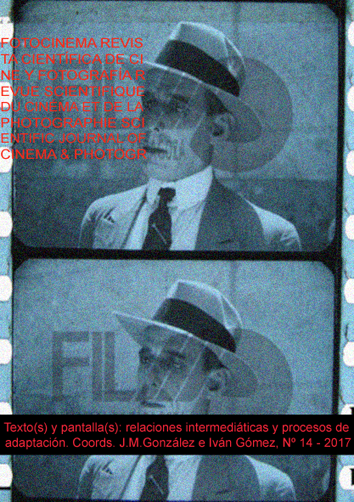Ensayo de un crimen. De la página a la pantalla
DOI:
https://doi.org/10.24310/Fotocinema.2017.v0i14.3572Keywords:
cine, literatura, melodrama, revolución méxicana, adaptación y recepción, Cinema, Literature, Mexican Revolution, Adaptation and Reception.Abstract
El objetivo de este artículo consiste analizar la adaptación o “transformación” de la novela de Rodolfo Usigli, Ensayo de un crimen (1944) llevada a cabo por Luis Buñuel en 1955. Con este fin, abordamos las últimas aportaciones teóricas en torno a la adaptación cinematográfica, que van más allá de la vieja dialéctica fidelidad/ infidelidad. A la vez, consideramos el papel de Buñuel dentro de la cinematografía mexicana. Dentro del análisis comparativo de los dos textos, examinamos las divergencias y convergencias que se producen en ambos al nivel de la historia y del discurso. Además, alojamos las dos obras en su contexto socio-histórico para investigar y contrastar el modo en el que cada una refleja a su manera dos épocas distintas de la historia de México en el siglo XX y dos visiones de la sociedad posrevolucionaria. Finalmente, observamos la manera en que el film de Buñuel reivindica el valor artístico de la fuente literaria.
Abstract:
This article aims to analyse Luis Buñuel’s adaptation or “transformation” of Rodolfo Usiglis’s novel “Ensayo de un crimen (“The Criminal Life of Archibaldo de la Cruz”) (1944) in 1955. Thus, we consider the most recent theoretical approaches to adaptation, which go beyond the traditional dialectic fidelity/infidelity. We also focus on Buñuel’s role within Mexican cinema. During the comparative analysis, we examine the differences and similarities between the two texts on the level of story and discourse. Moreover, we place both works in their social-historical context in order to discover and contrast the way in which each one reflects two different periods in Mexican history and two different visions of post- revolutionary society. Finally, we show how Buñuel’s film has contributed to the artistic prestige of the literary source.
Downloads
Metrics
References
Acevedo-Muñoz, E. (2009). ’Ensayo trémulo’: Un desencuentro literario entre Buñuel y Almodóvar. En Buñuel y/o Almodóvar. El laberinto del deseo. Letras Peninsulares, v.21, 1, primavera.
Buñuel, L. (2012). Mi último suspiro. Barcelona: Debolsillo.
Cummings, G.T. (2006). Buñuel y la novela Hispana: Un estudio de sus transposiciones Mexicanas, (Dissertation). Detroit: Wayne State University.
De la Colina, J. y Pérez Turrent, T. (1986). Luis Buñuel. Prohibido asomarse al interior. México: CNCA.
Evans, P.W. (2004). The Films of Buñuel. Oxford: Oxford U.P.
Fernández Ferrrer, A. Buñuel acude a la cita: Ensayo de un crimen en Carne trémula. Turia, nº 76, noviembre 2005-febrero 2006.
Fuentes, V. (1989). Buñuel, cine y literatura. Barcelona: Salvat Editores.
Fuentes, V. (1993). Buñuel en México. Teruel: Instituto de Estudios Turolenses.
Fuentes, V. (2000). Los mundos de Buñuel. Madrid: Akal Ediciones.
Fuentes, V. (2005). La mirada de Buñuel. Cine, literatura y vida. Madrid: Tabla Rasa.
Fuentes, V. (2013). Buñuel, del surrealismo al terrorismo. Valencia: Renacimiento.
García-Abad, M. T. (2003). Epstein y Lorca: Poesía y Cine. En VVAA., La poesía en el cine. Málaga: Revista Litoral.
Genette, G. (1989). Palimpsestos. La literatura en segundo grado. Madrid: Taurus.
Ibáñez, J. (2003). Más allá de la sociología. El grupo de discusión: Técnica y crítica. Madrid: Siglo XXI.
Kinder, M. (1993). Blood Cinema. The Reconstruction of National Identity in Spain. Los Angeles: University of California Press.
Lillo, G. (2015). El paradigma de lo nacional y sus desdoblamientos en el cine mexicano de Buñuel. Nationbuilding en el cine mexicano desde la Época de Oro hasta el presente. Schmidt-Welle, Friedhelm y Wehr, Christian (eds.). México: Iberoamericana.
Monegal, A. (1993). Luis Buñuel de la literatura al cine: Una poética del objeto. Barcelona: Anthrophos.
Pérez Bowie, J. A. (2008). La adaptación como encrucijada. Leer el cine. La teoría literaria en la teoría cinematográfica. Salamanca: Universidad de Salamanca.
Pérez Rodríguez, G. Ensayo de un crimen: la eterna discrepancia entre escritor y director. Revista Electrónica, IMÁGENES, Instituto de Investigaciones Estéticas. Disponible en http://estéticas.unam.mx/revista-imágenes/rearchivos/dearch-perez01.html - Consultado 11/0972015.
Quinn, P. (2009). Filosofía de la descomposición. En Duque., F. (ed)., La mala conciencia de la modernidad, Madrid: Círculo de Bellas Artes.
Schmidt-Welle, F. (2011). ¿Luis Buñuel en México. Una época de oro? En El exilio republicano español en México y Argentina, Pagni, A. (ed.). Madrid: Vervuert.
Stam, R. (2009). Teoría y práctica de la adaptación. México: UNAM.
Usigli, R. (1944). Ensayo de un crimen. Buenos Aires: Centro Editor de América Latina.
Wolfenzon, C. (2006). Los Dos Ensayo(s) de un Crimen: Buñuel y Usigli. Chasqui, vol. 35, núm.1, mayo.
Downloads
Published
How to Cite
Issue
Section
License
All contents published in Fotocinema Revista científica de cine y fotografía are protected under the Creative Commons Attribution-NonCommercial-ShareAlike 4.0 International (CC BY-NC-SA 4.0) license. All about this license is available in the following link: <http://creativecommons.org/licenses/by-nc-sa/4.0>
Users can copy, use, redistribute, share and exhibit publicly as long as:
- The original source and authorship of the material are cited (Journal, Publisher and URL of the work).
- It is not used for comercial purposes.
- The existence of the license and its especifications are mentioned.
There are two sets of authors’ rights: moral and property rights. Moral rights are perpetual prerogatives, unrenounceable, not-transferable, unalienable, imprescriptible and inembargable. According to authors’ rights legislation, Fotocinema. Revista científica de cine y fotografía recognizes and respects authors moral rights, as well as the ownership of property rights, which will be transferred to University of Malaga in open access. The property rights are referred to the benefits that are gained by the use or the dissemination of works. Fotocinema. Revista científica de cine y fotografía is published in an open access form and it is exclusively licenced by any means for doing or authorising distribution, dissemination, reproduction, , adaptation, translation or arrangement of works.
Authors are responsable for obtaining the necessary permission to use copyrighted images.













13.png)



